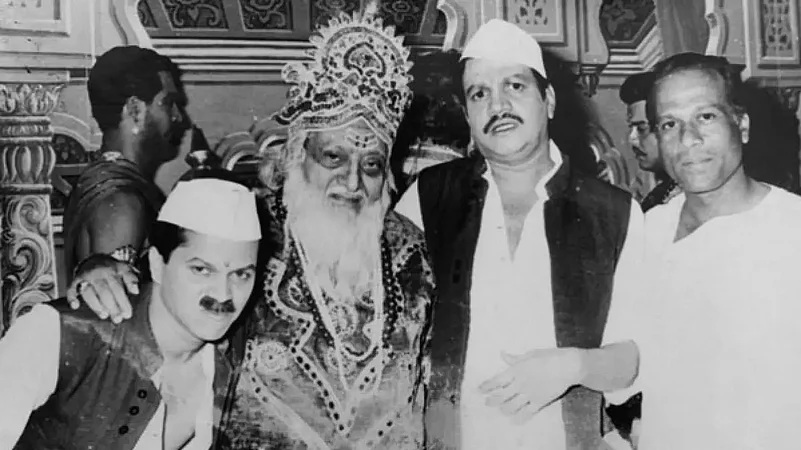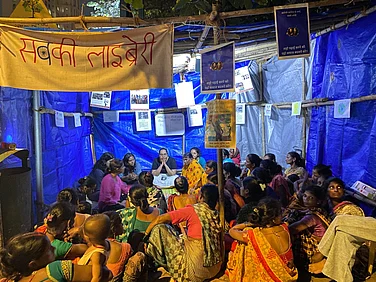Bombay once had an unwritten rule when it came to setting up staging areas for theatre. They had to be located in close proximity to a railway station, bar and a red-light area. The first is because it would make it easy for theatre-goers to walk to and from the nearest affordable means of transportation. Bars and red-light areas needed to be close enough, perhaps because they were the watering holes where the city’s working class could shed their inhibitions before or after watching a theatre performance.
Along Falkland road, which cuts through Mumbai’s biggest red-light area, Kamathipura, lies a smallish artery, the Patthe Bapurao road. It is less than a kilometer in length. It’s named after the legendary Marathi poet, singer and tamashgir (tamasha performer) Patthe Bapurao -- who was born as Shridhar Kulkarni -- with over 16,000 powadas and bharuds to his credit. Powadas are ballads glorifying Maratha valour, while bharuds refers to dramatically performed songs with double-edged interpretations.
Bapurao, a Brahmin, then chose to marry a courtesan from the Mahar caste, Pawala and all hell broke loose. His theatre performances were banned, until, according to renowned playwright and director Ramu Ramanathan, the manager of a local theatre decided to tap into the blazing caste controversy.
While the exact year when the unique stage performance was enacted isn’t clear, the manager put up both, the shunned Bapurao and Pawala on stage and ‘married’ them again. The wily manager charged a fee for those who wanted to watch the spectacle. He reportedly made more money than his regular theatre shows.
“The wedding itself became a performance on stage,” Ramanathan says.
Mumbai, India’s most populous metropolis, is a city used to being under the spotlight. The city itself is a stage as it were, with its billions playing their bit parts on the isle.
Parsis and Marathi theatre groups were first off the blocks in the early race to grab centre-stage in Bombay around the mid-1800s.
Ten years after Vishnupant Bhave’s Sanglikar Natak Mandali staged the first Marathi play ‘Sita Swayamwar’ in Sangli in 1843, he moved to Bombay in 1853. His first play ‘Khel Akhyan’, like Sita Swayamwar drew inspiration from classical mythology.
Reformer Jyotiba Phule’s play ‘Tritya Ratna’ in the late 1800s put the spotlight on social realities including the exploitation of lower castes by Brahmins, was a subaltern counter to Bhave’s predominant narrative which involved glorification of mythology.
Parsi theatre on the other hand focused on grand spectacles to tap into popularity, as well as adaptation of plays by popular English playwrights including Shakespeare. One of the first plays staged in Bombay by the Parsi Natak Mandali was the classical tragedy ‘Rostum and Zohrab’ based on the 10th-century epic by Persian poet Abolqasem Ferdowsi.
“Parsis had well-organized theatre groups with payments, contracts. They remade Shakespeare’s plays, by Indianising or Hindustanising them. Their plays were interesting because of the level of spectacle involved… The level of stagecraft for example, how they would manipulate certain effects, choreograph flying objects, building grand spectacles on stage… And to be able to do that with that level of precision was quite spectacular,” according to Ramanathan.
While English theatre too had its own presence in the British-occupied city, especially among the colonials and city elite, Marathi theatre took a nationalistic bent with the emergence of freedom fighters like Bal Gangadhar Tilak, Krushnaji Khadilkar, etc.
Bombay was already a beacon of industrialization and had attracted waves of migration from the Konkan and Marathwada and other regions from the Bombay presidency. Tilak’s plan to use popular theatre to attract this working-class population to the freedom struggle was not unknown to the British.
In the midst of this game of hide and seek between those who ran the stage and those in charge of statecraft, Khadilkar’s play ‘Kichak Vadh’, staged by the Maharashtra Natak Mandali needs to be singled out.
The play was based on a segment in the Mahabharata, in which Draupadi urges Bheem to kill Kichak, a royal courtier, after he tries to molest her. The play had a dual tone. One which dealt with the epic and the other, was a camouflaged and telling reference to colonial politics with an embedded nationalist response.
“It was a pauranik (mythical) drama dealing with the state of Pandavas in exile, when they were serving incognito at the court of King Virat as lowly servants. The play compared their condition to that of Indians serving as slaves under the British. Kichak symbolised Lord Curzon, and Draupadi, the partition of Bengal… Her appeal to Dharma (Yudhishthir) and Bhim to take up arms for her safety and to crush the enemy alluded to (Gopal Krishna) Gokhale and Tilak and their respective parties,” says Aravind Ganachari in his paper ‘The contribution of Marathi theatre to the growth of nationalism 1897-1913.'
Marathi theatre’s tryst with modernity and experimentation came after independence in the 1960s and 70s, largely credited to emerging stalwarts like Vijay Tendulkar, Vijaya Mehta, Mahesh Elkunchwar, etc.
Their focus moved from the past to more existentialist subjects.
While Marathi experimental theatre still catered to the elite middle class, there were others like ‘Malvan’s Amitabh Bachchan’ Macchindra Kambli who also emerged on the scene, on the shoulders and talent of the Konkani textile workers, whose viewership was key to the sustenance of mass Marathi theatre.
His play Vastraharan, a comic farce inspired by the disrobing of Draupadi episode the Mahabharata, ran into 5,000 repeat shows across Mumbai, Maharashtra and other parts of the country.

While Kambli enthralled the masses, the protagonists of experimental theatre, continued to push the boundaries of not just Marathi, but Indian theatre as well.
And Rangayan, a Marathi theatre group founded by Mehta, Tendulkar, Dr. Shriram Lagoo and Arvind Deshpande, was at the forefront.
“I was reading a lot about British and American theatre. I knew what experimental theatre meant in those countries. I often wondered whether we had anything like that. Rangayan came the closest to that in Marathi of course,” playwright Mahesh Elkunchkar, who was a part of the theatre group said in an interview in 2015.
“What changed was the way plays were being presented. Even though they continued to be (set) in the living room…instead of being highly dramatized with poetic flourishes, which Indian theatre was renowned for, these guys suddenly were writing these half sentences, broken sentences. There were a new bunch of actors who were no longer deriving their strength from tradition,” Ramanathan says.
Translation of plays also came into vogue, with Girish Karnad translating Tendulkar’s radical Marathi plays into Kannada and vice versa, bridging what was considered as one of the most significant gaps in Indian theatre, where one linguistic or regional pocket of theatre would be oblivious to what happened in another pocket.
Marathi theatre still continues to account for nearly 60 percent of the around 1,500 plays that are staged in Mumbai every year even now.
While Bollywood movies rule the city which founded the industry, Hindi drama in Mumbai, could not replicate the success of its onscreen cousin on stage. One of the reasons for this deficiency is credited to the lack of nurturing of Hindi tradition and folk-art forms, according to Mumbai-based theatre director and actor Nadira Babbar.
In the 1940s, two organizations began to make an impact in Hindi theatre. One was the Indian People’s Theatre Association, a nationalist theatre group that included Prithviraj Kapoor, Balraj Sahni, Ritwik Ghatak Salil Choudhary, Pandit Ravi Shankar among others. The objective of the group was to create a cultural awakening in India and nudge artists towards the freedom struggle, which had reached its peak.
Kapoor, an acclaimed actor, also founded the Prithvi theatre group, a traveling clan of artists who toured Indian cities with their plays. Juhu’s Prithvi theatre was conceptualized when Kapoor decided to root his passion for theatre in Mumbai.
His dream was brought to fruition by his son Shashi and the latter’s wife Jennifer, who physically finally created the space which served as a lynchpin for Hindi theatre and Mumbai’s auteurs, who gravitated to the Prithvi theatre for decades.
Prithvi theatre has served as a watering hole for artists, writers, and actors, some of whom made it big in cinema later.
Actor Naseeruddin Shah in an interview in 2019, credits Prithvi Theatre as a major credit to his career.
“Prithvi was a major blessing because we could not think of performing regularly. I'd attribute Motley's survival largely to Prithvi as it's the only theatre in the world without an eye on profits or on corporate money,” Shah said. Motley is a theatre group started by Shah and co.
Like Hindi theatre, English theatre too has been unable to grab the same foothold in Mumbai as compared to the dominion established by Marathi and Gujarati regional theatre.
The Theatre Group of Bombay was one of the earliest English theatre group started by Sultan Padamsee in 1941. Padamsee claimed his group was inspired by ‘Group Theatre’, a New York-based theatre collective. The Padamsee – Sultan, Alyque, Daisy - clan has been synonymous with English stage productions in Mumbai, with the more recent years witnessing the rise of playwrights like Mahesh Dattani, Rahul Da Cunha, artist and director Rajat Kapoor, etc.
Boman Irani, one of the most popular actors in Mumbai’s English theatre, credits his craft as an actor to Alyque Padamsee, but also bemoans the shortcomings in the English theatre craft in the city.
“I think, as far as English theatre is concerned, you need to speak the language that audiences can identify with... We are an English-speaking audience but the plays don't show the kind of English we speak. There are traces of an American accent... Also there is a dearth of originality. We need our generation of playwrights,” Irani told the Mumbai Theatre guide in an interview.
Gujarati theatre was nursed by the early Parsi theatre pioneers of Mumbai. The region where the language originated was a part of the Bombay Presidency and Gujarati speakers were embedded in the city’s fabric.
Gujarati folk theatre was rooted in the Bhavai folk form, which dates back seven centuries. After relying largely on the folk form for a while, playwrights like CC Mehta and Ranchhodlal Dave came to be regarded as the doyens of Gujarati theatre in the early 1900s. Their theatre tried to explore current social themes, like in Mehta’s ‘Aag Garhi’ or fire engine, which dealt with the dilemmas of an unwell fireman.
Gujarati theatre still has a loyal following in the city, even though it’s a more expensive affair than say watching a Marathi play in terms of ticket pricing.
“A good Gujarati commercial play at Bhaidas hall (in Vile Parle, a Mumbai suburb) would work independently of Bollywood cinema even today,” says Ramanathan.
The reasons he spells out are a loyal audience, an established grip over organizational logistics and the fact that auditoriums continue to host multiple shows every day.
Unlike Delhi, where grants and freebies are linked to the popularity of theatre, in Mumbai, theatre is box-office driven.
“Bombay theatre is box office driven. Delhi is about free passes, grants, etc. In Bombay, it is survival of the fittest and money drives money. All the Gujarati Marathi producers, they make money on a play, park it in their kitty and then take the next play they stage,” he says.
Another unique aspect about Mumbai’s theatre, Ramanathan says, is that it is perhaps the only city where popular theatre is performed in four languages. A new trend in the city, he says, is the emerging Kannada theatre in the city.
The connection that theatre producers and cast share with the audience are extremely real, the playwright says. He recalls a recent instance at the Bhaidas hall.
A late-night play, which had a delayed start, was suddenly stopped midway. An actor on stage stepped out of character to remind viewers that they could leave the auditorium, in case they wanted to reach the nearby station in time for the last train.
This symbiotic relationship between theatre performers and their patrons has forged a loyal audience for the stage and ensured continuity of regional theatre in the city, where Bollywood otherwise tends to dictate dreams.





















